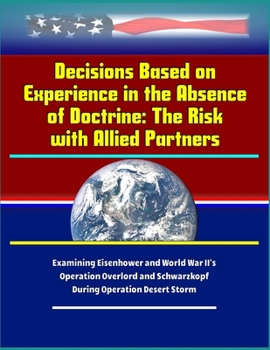Decisions Based on Experience in the Absence of Doctrine: The Risk with Allied Partners - Examining Eisenhower and World War II's Operation Overlord a
General Dwight D. Eisenhower commanded one of the largest multinational amphibious operations during World War Two, Operation Overlord. While Eisenhower identified operational risks, there were also unknown risks that came from conducting the operation with allies. General Norman Schwarzkopf, faced a similar situation of competing risks for Operation Desert Storm. Schwarzkopf had amassed a coalition of thirty-three allies, and needed to weigh the risk of the alliance against the many dangers of Iraq, including the use of tactical ballistic missiles. To add to Schwarzkopf s challenges, he faced the risk of the alliance dissolving with the threat of Israel's entrance into the war against Iraq. Commanders must identify and assess risk for all operations. However, during multinational operations, the U.S. Army and joint doctrine are silent in their discussion of how to assess and mitigate risk for operations involving allied partners. Therefore, a commander must identify, assess, and mitigate risk another way when including allies as part of a multinational operation. By examining Operations Overlord and Desert Storm through a methodology of structured focused comparison, this study examined how these two commanders understood coalition risk, and what steps they took to mitigate it. It examined the relationship between education and experiences that shaped their ability to influence the planning of their operations.This compilation also includes a reproduction of the 2019 Worldwide Threat Assessment of the U.S. Intelligence Community.When Operation Overlord began on June 6, 1944, General Dwight D. Eisenhower, Supreme Allied Commander of Europe, gave the "green light" to one of the U.S. military's largest amphibious operations in its history. Other allied countries included in the operation were Canada, Britain, and France. Knowing that failure of the operation risked losing the war, Eisenhower had to weigh the risks of the operation and the alliance. He had to ensure he had reduced the risks enough to accomplish the coalition's objectives for Operation Overlord, and not jeopardize follow-on operations or the war. While Eisenhower identified operational risks, there were also unknown risks that came from conducting the operation with allies as part of a coalition. When Operation Desert Storm began on January 17, 1991, General Norman Schwarzkopf Jr., Commander-in-Chief of U.S. Central Command (CENTCOM), faced a similar situation of competing risks in the Middle East. Schwarzkopf had amassed a coalition of thirty-three allies from around the world that included many non-Western nations. He needed to weigh the risk of the alliance against the many dangers of Saddam Hussein and his large military, including the use of tactical ballistic missiles. To add to Schwarzkopf s challenges, he faced the risk of the alliance dissolving with the threat of Israel's entrance into the war against Iraq. Both men faced enemies that were battle tested, and well dug into their defensive positions. Both men faced high casualties, allies with competing political demands, the potential loss of their militaries, and the loss of civilian support if their operations failed. In addressing this risk, both men relied on a mixture of education and experience to overcome an uncertain situation.Contents: 1. Introduction * Statement of the Problem * Definition of Terms * Hypothesis * Research Questions * Organization of the Study * 2. Literature Review * Risk Management Doctrine * Army and Joint Decision-Making Models * Expected Utility Model * Prospector Theory Model * Natural Decision Making (NDM) Model * 3. Methodology * 4. Case Studies * Operation Overlord * Operation Desert Shield and Desert Storm * 5. Analysis and Findings * 6. Conclusion
Format:Paperback
Language:English
ISBN:1699177325
ISBN13:9781699177327
Release Date:January 1
Publisher:Independently Published
Length:76 Pages
Weight:0.44 lbs.
Dimensions:0.2" x 8.5" x 11.0"
Related Subjects
HistoryCustomer Reviews
0 rating





